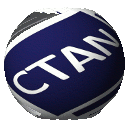Directory macros/latex/contrib/hereapplies
Here Applies
A LaTeX package for referencing groups of pages that share something in common
Overview
Here Applies is a LaTeX package that allows to collect groups of labels and reference them altogether. It can be used for creating informal glossaries that cross-link concepts to their applications, or simply mentioning multiple pages that share something in common.
The package offers two commands: \hereapplies and \whereapplies (plus their “starred” versions \hereapplies* and \whereapplies*). In both cases an identifier is passed as argument, and this can be any string invented in the moment (\hereapplies additionally supports more than one identifier in the form of a comma-separated list).
Every time \hereapplies is invoked with known identifiers, the document is made aware that the place shares some kind of connection with other places in which the same identifiers were used. And so, every time the \whereapplies command is invoked with a known identifier, all occurrences of the latter within the entire document will be printed in the form of a linkable page list (e.g. “pp. 1, 5, 8–9, 14–20…”).
As \hereapplies is designed to be invoked in the middle of a chapter or a section and that location must be made linkable, the \phantomsection directive is invoked by default before a label is added. To avoid calling \phantomsection, the “starred” command \hereapplies* is available.
Finally, like \whereapplies resembles a pluralizable version of \pageref, its “starred” version \whereapplies* will resemble a pluralizable version of \pageref*.
If you use LyX, the package ships a LyX module as well (please check the lyx-module subdirectory).
Example usage
The following LaTeX manuscript
\documentclass{article} \usepackage{hereapplies} \begin{document} \title{Some title} \author{Some author} \maketitle This is concept one. To find this concept applied, please see \whereapplies{conceptOne}. This is concept two. To find this concept applied, please see \whereapplies{conceptTwo}.\newpage \hereapplies{conceptOne} This is page \thepage. As you can see, ``concept one'' applies here.\newpage \hereapplies{conceptTwo} This is page \thepage. As you can see, ``concept two'' applies here.\newpage \hereapplies{conceptOne, conceptTwo} This is page \thepage. As you can see, both ``concept one'' and ``concept two'' apply here.\newpage \hereapplies{conceptTwo} This is page \thepage. As you can see, ``concept two'' applies here.\newpage \hereapplies[myref]{conceptOne} This is page \thepage. As you can see, ``concept one'' applies here. This point in the document is labeled \texttt{myref}. \end{document}
will generate the hereapplies-example.pdf document attached.
A minimal tutorial
Command \hereapplies[label]{identifiers}
The \hereapplies command notifies the document that one or more identifiers apply to a particular point and adds a label to it.
If the optional argument is passed the label created will be named accordingly, otherwise an opaque name will be chosen for it. This argument may contain only what is legal for \pageref.
The identifiers argument must be a comma-separated list of identifiers (leading and trailing spaces around each member will be ignored). Each of these strings will remain confined within the internal scope of the package and will not create conflicts with possible macros or labels of the same names.
After storing some internal values, \hereapplies will expand exactly to
\phantomsection\label{...}
Its “starred” version (\hereapplies*) will not invoke the \phantomsection directive.
Command \whereapplies{identifier}
The \whereapplies command prints all the occurrences of an identifier, in the form “p. …” or “pp. …” (with page range support).
The identifier argument will remain confined within the internal scope of the package and will not create conflicts with possible commands or labels of the same name. Leading and trailing spaces around this string will be ignored.
If the same identifier is not passed to \hereapplies at least once throughout the document, \whereapplies will print “??”.
The “starred” version of this command (\whereapplies*) will use \pageref* instead of \pageref for generating the page list.
Internationalization
Currently the localization of Here Applies is not automatic. It is possible however to control the strings generated by overwriting the four macros \hapage, \hapages, \hadelimiter and \halastdelimiter. For example, writing at the beginning of a document
% German translation of **Here Applies** % English: "p.\ " \gdef\hapage{S.\ } % English: "pp.\ " \gdef\hapages{S.\ } % English: "\ and\ " \gdef\halastdelimiter{\ und\ } % English: ",\ " (exactly like in German -- leave it) %\gdef\hadelimiter{,\ }
will translate “pp. 2, 4 and 6” into “S. 2, 4 und 6”.
Get involved
If you wish to get involved, please do not hesitate to send merge requests or participate in the discussion. The package is also available on CTAN under macros/latex/contrib/hereapplies/. For any issue, please drop a message.
Free software
Here Applies is free software. You can redistribute it and/or modify it under the terms of the AGPL license version 3 or any later version. See COPYING for details.
Download the contents of this package in one zip archive (424.2k).
hereapplies – A LaTeX package for referencing groups of pages that share something in common
Here Applies is a LaTeX package that allows to collect groups of labels and reference them altogether. It can be used for creating informal glossaries that cross-link concepts to their applications, or simply mentioning multiple pages that share something in common.
| Package | hereapplies |
| Bug tracker | https://github.com/madmurphy/hereapplies.sty/issues |
| Announcements | https://github.com/madmurphy/hereapplies.sty/releases |
| Repository | https://github.com/madmurphy/hereapplies.sty |
| Developers | https://github.com/madmurphy |
| Version | 1.0.2 2023-10-24 |
| Licenses | GNU General Public License, version 3 or newer |
| Copyright | 2022 madmurphy |
| Maintainer | madmurphy |
| Contained in | TeX Live as hereapplies MiKTeX as hereapplies |
| Topics | Label and References |
